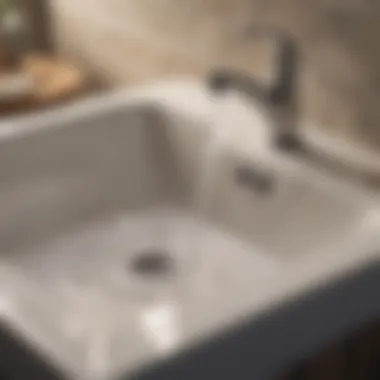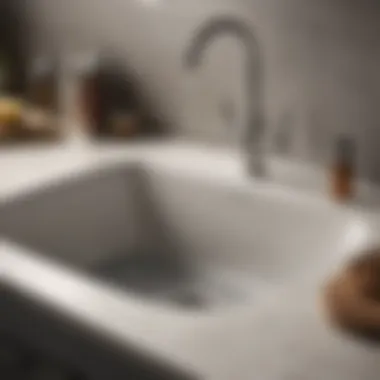Unclogging a Slow Draining Sink: A Comprehensive Guide


Intro
A slow draining sink is more than just an annoyance; it can signify deeper plumbing issues. Homeowners often struggle with this common problem, and it’s crucial to understand both the causes and the solutions. This guide will illuminate effective methods for unclogging a sink, helping you maintain a smoothly functioning plumbing system.
Common causes of slow drainage
Several factors can contribute to a sink draining slowly. Most common include:
- Buildup of debris: Hair, soap scum, and food particles can accumulate in the drain over time.
- Pipe corrosion: Old pipes may corrode, resulting in decreased water flow.
- Improper installation: Poorly installed plumbing can lead to insufficient drainage.
- Grease buildup: Disposal of grease down the sink can cause significant blockages.
Understanding these causes can help inform the unclogging process.
Practical Steps for Unclogging a Sink
Unclogging a slow draining sink can often be accomplished with simple household tools and techniques. Below are practical steps that can be taken:
1. Use a Plunger
A plunger can effectively remove minor clogs.
- Remove any standing water from the sink.
- Position the plunger over the drain, ensuring a tight seal.
- Push down firmly, then pull up quickly to create suction.
- Repeat multiple times until the water drains properly.
2. Try a Mixture of Baking Soda and Vinegar
This natural combination is useful for loosening debris inside the pipes.
- Pour a half-cup of baking soda into the drain.
- Follow immediately with a half-cup of vinegar.
- Cover the drain with a cloth, letting the reaction work for 30 minutes.
- Flush with hot water to clear out any remaining debris.
3. Use a Drain Snake
A drain snake can reach deeper clogs that a plunger cannot.
- Insert the snake into the drain until you feel resistance.
- Twist the snake to break up the blockage and pull it out.
- Run hot water to ensure everything is clear.
4. Check the P-Trap
The P-trap can collect debris over time.
- Place a bucket underneath it to catch any water.
- Unscrew the P-trap and clean out any buildup.
- Reattach and run water to check for leaks.
Preventive Maintenance
Prevention is key to avoiding future clogs. Below are essential maintenance tips:
- Regular cleaning: Pour hot water down the drain weekly.
- Mind your waste: Avoid putting grease, coffee grounds, or fibrous materials down the sink.
- Install a drain strainer: Using a strainer can catch debris before it enters the pipes.
By following these maintenance tips, homeowners can prolong the life of their plumbing system.
Expert Assistance
If troubleshooting efforts do not resolve the issue, it may be time to consult a professional plumber. Look for:
- Experience in plumbing issues specifically related to sinks.
- References or reviews from previous customers to gauge their reliability.
- Estimates of repair costs before committing.
A qualified plumber can diagnose underlying issues and recommend effective solutions, preventing future complications.
Culmination


Unclogging a slow draining sink is certainly achievable with the right understanding and tools. By actively maintaining your plumbing, you can avoid frustrating scenarios and ensure water flows smoothly. If all DIY methods fail, do not hesitate to reach out to a professional. They can save time and potentially larger plumbing headaches in the future.
Understanding Slow Draining Sinks
Slow draining sinks are a common, yet often overlooked issue in many households. Understanding the dynamics of this problem is crucial for effective management and long-term maintenance of a functional plumbing system. This section aims to illuminate the factors that contribute to slow drainage and outline the importance of addressing these issues promptly.
Definition of Slow Drainage
Slow drainage occurs when water takes an unusually long time to flow through the sink, often leading to pooling around the drain. In most instances, the expected drainage time for sinks ranges from several seconds to a couple of minutes, depending on numerous factors like sink design and water pressure. When this time increases significantly, it not only hampers daily activities but may also indicate underlying issues within the plumbing.
Importance of Addressing Drainage Issues
Timely intervention regarding slow draining is essential. Ignoring this situation can lead to several negative consequences, such as:
- Increased Likelihood of Clogs: Persistent slow drainage often leads to complete blockages, requiring invasive techniques for resolution.
- Potential Damage: Over time, stagnant water can cause deterioration of pipes due to corrosion or mold growth.
- Unpleasant Odors: Standing water can become a breeding ground for bacteria, resulting in foul smells that permeate your space.
It is important to stress that identifying the cause of slow drainage early can save time, effort, and potential costs associated with professional plumbing services.
Common Causes of Slow Draining Sinks
Understanding the common causes of slow draining sinks is essential for anyone facing plumbing issues. By identifying these factors, homeowners can take effective measures to prevent further complications. The importance of recognizing these culprits lies in the ability to act promptly, which can save time, money, and effort in the long run. Moreover, knowing how debris and blockages occur enables better maintenance practices, ensuring the plumbing system remains functional.
Accumulation of Debris
Hair
Hair is one of the main contributors to slow drains. It easily clogs pipes, especially when it combines with soap residue. Its light and thin material often gets stuck in narrow passages, creating a barrier for water flow. The key characteristic of hair is its ability to tangle, which amplifies blockage issues over time. Addressing hair accumulation can significantly improve drainage efficiency. Regular cleaning of drain covers can help reduce hair buildup, making it an important focus for homeowners.
Soap Scum
Soap scum builds up along the pipes as soap interacts with minerals in the water. This residue not only slows drainage but also leads to unpleasant odors. The unique feature of soap scum is its sticky texture, which attracts other debris. Preventing soap scum formation involves using liquid soaps instead of bar soaps, which tend to leave more residue. Regular cleaning can keep drains clear, making it essential to control this aspect of drainage maintenance.
Food Particles
Food particles can accumulate in kitchen sinks, especially when improper disposal methods are used. Small bits may lead to larger clogs as they trap grease and other organic matter. A notable characteristic of food particles is their biodegradable nature, which, while beneficial in some contexts, can cause significant problems in drain systems. Using sink strainers can help minimize the amount of food going into drains, making it a preferred choice when discussing effective maintenance solutions.
Pipe Partial Blockages
Grease Buildup
Grease buildup is a common issue in kitchen sinks, often occurring when leftover cooking fats are poured down the drain. Over time, this grease hardens, forming a thick layer along the pipe walls. The key aspect of grease buildup is its sticky nature, which attracts other debris, worsening the blockage. Regularly disposing of grease properly can prevent this buildup, making it an important practice for kitchen maintenance. However, excessive grease may require professional intervention, highlighting its potential seriousness.
Mineral Deposits
Mineral deposits occur when hard water evaporates, leaving behind minerals such as calcium and magnesium. These deposits can accumulate and reduce pipe diameter, leading to slow drainage. The unique characteristic of mineral deposits is their gradual formation, which often goes unnoticed until significant blockage occurs. Softening hard water with a water softener can help manage mineral build-up, thus benefiting overall plumbing maintenance.
Ventilation Problems
Ventilation problems stem from inadequate air flow in the plumbing system. Each drainage system needs a proper venting to work efficiently. When vents are blocked, it can create a vacuum effect, slowing water drainage capabilities. Recognizing these issues is vital to maintaining functional drainage over time, and timely checks can prevent additional complications.
Pipe Damage
Pipe damage can result from corrosion, extreme temperature changes, or shifts in foundation. Cracks in pipes can also occur, allowing debris to infiltrate more easily. Understanding the presence of pipe damage requires inspection, as visual signs may be subtle. Repairing damaged pipes promptly is critical for maintaining effective drainage and preventing more severe plumbing issues.
Identifying the Symptoms of a Slow Drain
Understanding the symptoms associated with slow drains is crucial for effective intervention. Early recognition of these signs can prevent minor issues from evolving into significant plumbing problems. Homeowners, especially those who wish to maintain their plumbing systems, should know the symptoms that signal a need for action. Without timely clarity on these indications, one may face more extensive damage or costly repairs.


Visual Indicators
Visual cues often present the first evidence of a slow-draining sink. The most common indicator is the water level remaining stagnant in the basin. When you run the tap, instead of draining away quickly, water may linger or rise excessively. Another sign involves the presence of standing water, often coupled with visible debris on the surface. Both serve as key indicators of potential clogs.
- Cloudy Water: If the water appears murky, it may suggest contamination or buildup in the pipes.
- Bubbling Effects: As water drains slowly, air may become trapped underneath, causing bubbles to rise. This phenomenon can indicate deeper clogs.
Identifying these visual elements can help ascertain the immediacy of a clog before it worsens.
Unpleasant Odors
Foul smells emanating from the sink present another alarming symptom of a slow drain. Often, these odors arise due to decomposing food particles or accumulated grease trapped within the pipes. This stagnation encourages bacterial growth, leading to unnecessary health risks and unpleasant environments.
- Sewage Smells: A strong sewage odor indicates potential blockages or serious problems within the drainage system. It is vital not to ignore these signs.
- Stale Scents: If the sink has a stale smell, it often reflects buildup and formulating blockages. Homeowners should consider investigating to ensure preventative measures are taken.
Addressing these smells early can help maintain a healthy home environment and prevent further issues.
Recurring Pooling Water
Repeated occurrences of pooling water around the sink area indicate persistent slow drainage problems. This symptom not only causes inconvenience during use but can also lead to structural damage over time. Regular pooling suggests an ongoing issue that requires immediate attention.
- Daily Observation: If you notice water pooling consistently, it may signal that your plumbing is failing to properly dispose of water.
- Accumulation Signs: Pay attention to water accumulating even after minor use, such as brief handwashing. It shows that the drainage system may be compromised.
In summary, recognizing these symptoms early—visual indicators, unpleasant odors, and recurring pooling—can save time and cost in managing plumbing issues. This proactive approach empowers individuals to take steps before serious complications emerge.
DIY Methods to Unclog a Slow Draining Sink
When it comes to home maintenance, addressing a slow draining sink is a critical task. This issue doesn’t just cause inconvenience; it can lead to more severe plumbing problems if left unattended. Understanding and applying various DIY methods empowers homeowners to tackle these challenges efficiently. These methods are often cost-effective, require minimal tools, and can resolve situations that might otherwise necessitate professional intervention.
The focus here is on straightforward methods to unclog sinks that anyone can attempt. Using these techniques can save both time and money while ensuring that your plumbing remains functional. Moreover, knowing how to handle such issues can prevent recurring problems, enhancing the overall maintenance of your home.
Using a Plunger
Employing a plunger is one of the most well-known DIY techniques for clearing out clogs. To use a plunger effectively, ensure it forms a tight seal over the sink drain. Begin by filling the sink with a bit of water; this helps in creating suction. Position the plunger over the drain and push down firmly before pulling up quickly, repeating this several times. The pressure produced can dislodge debris trapped within the pipes.
Employing a Drain Snake
A drain snake is another useful tool for dealing with stubborn slow drains. Also known as a plumbing auger, it is designed to reach deeper into the pipes than a plunger. Insert the drain snake into the drain until you encounter resistance. Turn the snake while pushing gently; this action may help break through blockages of hair, grease, or other debris. After clearing the blockage, run hot water to flush any remaining particles down the drain.
Applying Baking Soda and Vinegar
A mixture of baking soda and vinegar offers a natural solution to drain clogs. Start by pouring about half a cup of baking soda directly into the drain, followed by an equal amount of vinegar. The two substances will react, creating fizzing bubbles. Allow this solution to work for at least 30 minutes before rinsing with hot water. This method not only helps in dislodging clogs but also neutralizes odors and cleans the pipes.
Hot Water Flush
Performing a hot water flush can be a simple yet effective method to unclog slow draining sinks. Begin by boiling a pot of water. Carefully pour the hot water directly into the drain in stages. This technique can help dissolve soap scum and grease that accumulate over time. It is advisable to repeat this process a few times if the clog is stubborn.
"Regular maintenance and familiarizing yourself with these DIY methods can keep your plumbing system in optimal condition."
By employing these DIY methods, homeowners can maintain their plumbing systems efficiently and keep slow draining sinks at bay. The effectiveness of each technique can vary based on the specific cause of the drainage problem, but having these strategies enables a proactive approach to plumbing maintenance.
Preventive Measures for Drain Maintenance
Preventive measures for drain maintenance play a crucial role in maintaining the overall functionality of a plumbing system. Taking proactive steps can significantly reduce the likelihood of slow draining or clogged sinks. This not only saves time and effort but also minimizes the potential for costly repairs. Implementing these strategies allows for smooth water flow and extends the lifespan of plumbing infrastructure.
Regular Cleaning Practices
Regular cleaning is an effective method to prevent the buildup of debris and clogs in the drain. A simple routine can include clearing out hair, soap scum, and food particles before they accumulate. Doing this once a week can be beneficial.


- Materials Needed:
- Steps:
- Soft sponge or cloth
- A small bucket or container
- Broom or handheld vacuum
- Remove the sink drain cover if there is one.
- Use your hands or a tool to remove any visible debris.
- Wipe the area around the drain, removing any residue.
- Rinse the drain cover and put it back in place.
This simple act will help in managing the buildup and ensures that water can flow freely.
Use of Drain Covers
Utilizing drain covers can act as a barrier against unwanted materials entering the plumbing system. These covers can catch hair and food particles, preventing them from causing clogs deep within the piping.
- Benefits of Drain Covers:
- Easy to install and remove.
- Affordable and readily available at stores.
- Reduction in cleaning frequency as they capture debris.
It is wise to regularly clean these covers as well, ensuring they do not become a source of blockage themselves.
Routine Inspections
Conducting routine inspections of your plumbing system is another essential preventive measure. Regular checks can help identify any signs of trouble early on, such as dampness under the sink or slow drainage.
- What to Look For:
- Examine for visible leaks or cracks.
- Check for unusual noises when draining water.
- Inspect for pooling water around the sink.
Set aside time every few months to perform these inspections. Addressing minor issues proactively can prevent them from developing into significant problems.
"An ounce of prevention is worth a pound of cure."
By understanding these preventive measures, a homeowner can save much hassle and expense. Taking an active role in maintaining your drains will pay dividends in the long run.
When to Seek Professional Help
Addressing a slow draining sink can often seem straightforward, particularly with the many DIY methods available. However, there are times when professional intervention becomes necessary. Recognizing these instances saves time, money, and potential damage to your plumbing system. Engaging a specialist can provide long-term solutions, instead of temporary fixes.
Signs of Complicated Blockages
Sometimes, the source of a slow drain is not easily identifiable. Several signs can indicate that the blockage is more complicated than mere debris accumulation. Some of these include:
- Persistent Backups: If your sink continues to backup despite attempts to clear it, consider professional assistance.
- Failure of DIY Methods: Using a plunger or a drain snake repeatedly without success may indicate a deeper issue.
- Multiple Drains Affected: If slow drainage occurs in multiple locations, it could signal a wider plumbing problem requiring expert evaluation.
- Unpleasant Odors: Foul smells from the sink may indicate trapped debris or mold growth. This situation may require a thorough professional cleaning.
Evaluating the Need for Professional Tools
Often, household plumbing tools are insufficient to manage severe clogs. If you notice the aforementioned signs, ask yourself whether you have the right tools to tackle the problem. Professional plumbers possess specialized equipment, such as:
- High-Pressure Water Jets: These can dislodge stubborn blockages that a standard snake may not reach.
- Video Inspection Equipment: This technology allows plumbers to visually assess the state of pipes and identify problem areas.
- Drain Augers: More advanced than typical snaking methods, these tools can break through tough obstructions without damaging your pipes.
Working with professionals also provides the dual benefit of saving time and ensuring proper handling of plumbing systems. Many small issues can escalate into major repairs if not addressed on time, hence analyzing symptoms carefully is fundamental. If in doubt, do not hesitate to get a professional opinion. This proactive approach safeguards both your plumbing and peace of mind.
Culmination
In addressing the issue of a slow-draining sink, the significance extends beyond mere convenience. This article has traversed through various stages of understanding, diagnosis, and practical solutions. Recognizing the underlying causes of slow drainage equips homeowners with the knowledge to tackle their plumbing challenges effectively. Furthermore, the detailed exploration of DIY methods provides accessible approaches that can be implemented swiftly, thus enhancing the overall household functionality.
Summary of Methods and Importance
To summarize, the methods encapsulated throughout this guide are pivotal for maintaining a healthy plumbing system. Techniques like plunging, using a drain snake, or utilizing natural ingredients such as baking soda and vinegar serve not just to unclog but also to preserve the longevity of pipes.
- Utilizing a plunger is a tried-and-true method which can often resolve simple clogs.
- Employing a drain snake allows for deeper cleansing by reaching blockages further down the pipes.
- Baking soda and vinegar present a chemical-free solution that can dissolve buildup and odors effectively.
- Hot water flushes provide a simple yet impactful preventive measure that keeps grease and debris at bay.
The importance of knowing these methods lies in fostering independence from reliance on professional services, therefore saving time and money. Moreover, understanding these techniques contributes to proactive maintenance, which, as stated earlier, prevents future complications.
Final Thoughts on Drain Maintenance
Maintaining a well-functioning sink requires ongoing diligence. Regular cleaning practices and the use of drain covers can significantly mitigate the risks of blockages. Routine inspections further empower homeowners to address minor issues before they escalate.















